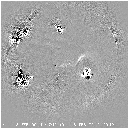Jets in Giant Interconnecting Loops
Science Nugget: Feb 12, 1999
1. Discovery
An SXT difference image from Feb. 8 caught our eye - the large loop structure
seen at the east limb (left) is dark at the top, bright at the bottom.
This implies a flow along the loop, going from north to south, over the
8-minute interval of the image pair.

This configuration strongly suggests a jet-like filling of the structure
by injection of plasma at the N footpoint. The inferred velocity would
be in the range 500-1,000 km/s, not so far from what we think the Alfven
speed might be. The difference image, incidentally, also shows a loop structure
expanding away from the active region in the SW quadrant of the Sun.
2. Background
Trans-equatorial loop structures have been an important curiousity on the
Sun since the earliest good X-ray images of the corona were made. The Babcock
picture of the solar dynamo, for example, does not offer an easy way to
make such loops. So, they have always provided cheap evidence that magnetic
reconnection occurred in the large-scale coronal field, on time scales
much faster than one might expect. Tsuneta (ApJ 456, 63L, 1996) has described
SXT observations related to such reconnection processes, in fact citing
variability as one of the arguments in favor of reconnection - magnetic
reconnection being one of the best ways theoretically to convert magnetic
energy into heating and X-ray visibility.
Do we see variability? Here is a series of observations spanning the
entire E limb transit of this week's structures:

These data are too recent for us to make a semi-continuous movie out
of, but the message is clear - the trans-equatorial loops show variations
on relatively short time scales. But in this example they are not energizing
(reconnecting) from the top, as Tsuneta's example appeared to show; instead,
if reconnection happens, it must be near the footpoint in order to excite
flows of the type shown in the first image above.
We've shown interconnecting loops in past SXT science nuggets; a first
suggestion was that the interconnecting loops grew up piecemeal, as
the ebb and flow of the supergranulation permitted. But cooler
heads prevailed and it became clear that these were semi-permanent
global structures, not created on short time scales but only illuminated
in a transient way.
3. Bigger discovery
How do flares affect the trans-equatorial interconnecting loops? No doubt
flares, and their associated coronal mass ejections, represent gross restructurings
of the solar corona. Another previous
SXT science nugget commented on flare effects in interconnections within
the same hemisphere; now we have the beautiful example (below) of a flare
effect on a trans-equatorial connection:
In the GOES time history on the right, the yellow vertical lines mark
the times of the before (white) and after (black) images in the difference
image (left). The flare led somehow to a drastic brightening of a pre-existing
large-scale structure - isn't that a natural conclusion?
4. So what, and who cares?
This is a question that NASA often asks. Here we believe we are hot on
the trail of quite important mechanisms for magnetic reconnection, or magnetic
restructuring, of the solar corona. It is a region of space dominated by
magnetohydrodynamic and/or plasma effects on scales far beyond our laboratory
experience. Thus its behavior may not be very intuitive. Observations such
as these may really help in deciphering the physics!
Summary listing of SXT science nuggets on interconnecting structures:
[1]
[2]
[3]
February 12, 1999: Hugh Hudson (email hudson@isass0.solar.isas.ac.jp)




